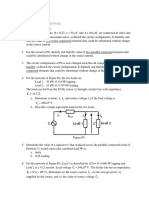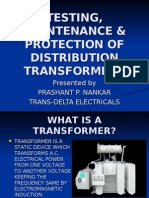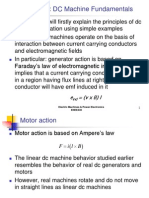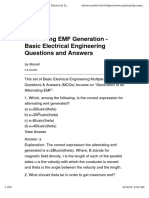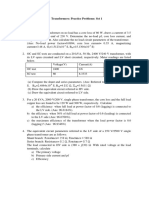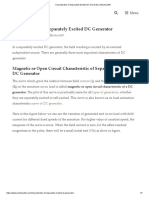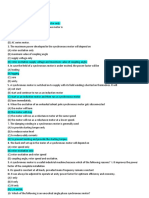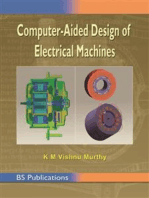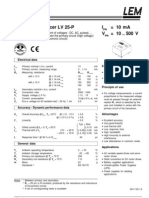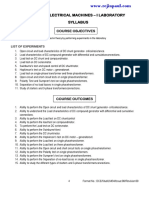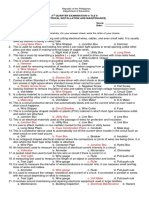Experiment 4 The DC Compound Generator: Muhammad Al-Ariff Bin Selamat (112215), Muhammad Azfar Amin Bin Ahmad Mokhtar
Experiment 4 The DC Compound Generator: Muhammad Al-Ariff Bin Selamat (112215), Muhammad Azfar Amin Bin Ahmad Mokhtar
Uploaded by
One Love Jah LoveCopyright:
Available Formats
Experiment 4 The DC Compound Generator: Muhammad Al-Ariff Bin Selamat (112215), Muhammad Azfar Amin Bin Ahmad Mokhtar
Experiment 4 The DC Compound Generator: Muhammad Al-Ariff Bin Selamat (112215), Muhammad Azfar Amin Bin Ahmad Mokhtar
Uploaded by
One Love Jah LoveOriginal Title
Copyright
Available Formats
Share this document
Did you find this document useful?
Is this content inappropriate?
Copyright:
Available Formats
Experiment 4 The DC Compound Generator: Muhammad Al-Ariff Bin Selamat (112215), Muhammad Azfar Amin Bin Ahmad Mokhtar
Experiment 4 The DC Compound Generator: Muhammad Al-Ariff Bin Selamat (112215), Muhammad Azfar Amin Bin Ahmad Mokhtar
Uploaded by
One Love Jah LoveCopyright:
Available Formats
Experiment 4
The DC Compound Generator
Muhammad Al-Ariff Bin Selamat (112215), Muhammad Azfar Amin Bin Ahmad Mokhtar
(113690), Siti Atiqah Binti Abdul Halim (112228), Pauline Chuo See Sze (112225)
School of Electrical & Electronic Engineering - Universiti Sains Malaysia
Abstract- This experiment is carried out to -To learn how to connect both the compound and
understand many application of generator in the differential-compound generators.
different type.The dc compound generator have field
windings that connected in series and parallel to the -To obtain the armature voltage vs armature current
armature. This two windings plays an important roles load curves for both generators.
in determine the characteristics of the compound
generator itself. It has two types, differential
compound and cumulative compound generator and
can be connected in long-shunt connection or short- B. Procedure of Experiment.
shunt connection. Differential dc compound
generator has constant voltage as the load increased. 1- The circuit was connected using Power Supply,
AC Voltmeter and Synchronous Motor/Generator
Index Terms - DC motor, Compound Generator.
as shown in Figure 9-1. The rheostat control knob
was set to its proper position for normal excitation.
I.INTRODUCTION The circuit was connected by using DC
Motor/Generator, DC Voltmeter/Ammeter and
The compound generator has a field winding in Variable Resistance as shown in figure 9-2.
parallel with the generator armature (the same as
a shunt-wound generator) and a field winding in
series with the generator armature (the same as a
series-wound generator).The two windings of the
compounded generator are made such that their
magnetic fields will either aid or oppose one
another. If the two fields are wound so that their
flux fields oppose one another, the generator is said
to be differentially-compounded. If the two fields
of a compound generator are wound so that their
magnetic fields aid one another, the generator is Figure 9-1
said to be cumulatively-compounded. In this
experiment, the properties of compound dc
generators under no-load and full-load conditions,
the connection of the compound and differential-
compound generator were studied.
A. Objective of Experiment
-To study the properties of compound dc generators
under no-load and full-load conditions. Figure 9-2
2-The Synchronous Motor/Generator was coupled Variable Resistance 8311
to DC Motor/ Generator with Timing Belt. The DC
Motor/Generator field rheostat control knob was DC Voltmeter/Ammeter 8412
turned to full clockwise position. The resistance
AC Ammeter 8425
switches was placed for no-load (all switches open)
Power Supply 8821
3- The Power Supply was turned on. Switch S was
closed. If EA does not build up, the Power Supply Connection Leads 8941
will be turned off and any two of the stator
connection leads on the Synchronous Motor were Timing Belt 8942
interchanged. The open circuit armature voltage
was measured. The field rheostat was varied. The
change in armature voltage EA was observed.
4-The field rheostat for a no-load current was
adjusted for a no-load current output voltage EA of
240 V dc. The load resistance was adjusted to II. THEORY
obtain each of the values listed in Table 9-1.
Self-excited generators have the disadvantages that
5-EA and IA for each of the values listed in the table change in their load current from no-load to full-
were measured and recorded. The Power Supply load cause changes in their output voltage. Their
was turned off. poor voltage regulation is due to three factors:
6-The connections were changed to series field a) The magnetic field strength, which in turn
only, so that the armature current flows through it reduces the armature voltage etc.
in the opposite direction. The drawing was b) The armature voltage drop (IR drop) from
completed as shown in figure 9-3. no-load to full-load.
c) The running speed of the driving motor
may change with load. (This particularly
true of internal combustion engines and
induction motors).
The two field windings (shunt and series) on the
compound generator are connected so that their
magnetic fields aid each other. Thus, when the load
current increases, this causes a drop in terminal
voltage which, in turn, cause the current through
the shunt-field winding decreases, reducing the
Figure 9-3 strength to the magnetic field. But, if the same
increases in load currents are made to flow through
7-The Power Supply was turned on. The field
the series-field winding, it will increase the strength
rheostat was adjusted for an EA of 240 V dc. The
of the magnetic field.
load resistance were adjusted to obtain each of the
values listed in the Table 9-2. EA and IA for each of Equation used in this experiment:
the values listed in the table were measured and
recorded. The Power Supply was turned off. Voltage regulation= [(Vnl – Vfl) / Vfl)] X 100%
Vnl = No-load voltage (V)
C. List of Instruments and Components Vfl = Full-load voltage (V)
DC Motor/Generator 8211
Synchronous Motor/Generator 8241
III. EXPERIMENTAL RESULTS -Noted that for differential compound generator,
the voltage is constant as the load is increased. This
-If the voltage builds up: is because of the current that flows in the series
winding which cause extra magnetic flux, which
=Yes
cause the voltage to be kept constant.
-The open circuit armature voltage, EA;
= 300 V dc
-Vary the field rheostat. Does the armature voltage
Test Your Knowledge
EA change?
1. Plot the recorded EA vs IA values form Table 9-2
>Yes. This is because the rheostat controls the
on the graph of Figure 9-4. Draw a smooth curve
amount of current that flow to the shunt field and
through your plotted points.
cause the magnetic field flux to be varied as the
rheostat varied. >
-Table 9-1
RL, Ω IA, A EA, V Power, W
Ea vs Ia
∞ 0.00 240 0.0
2403 0.10 240 24.0 300
1197 0.20 230 46.0
250
959 0.25 230 57.5
601 0.40 220 88.0 200
478 0.45 210 94.5
400 0.55 210 115.5 150
343 0.60 200 120.0 100
300 0.70 190 133.0
50
0
-Table 9-2
0 2 4 6 8 10 12 14 16
RL, Ω IA, A EA, V Power, W
∞ 0.00 240 0.0
2403 0.10 210 21.0
1197 0.15 160 24.0 2. Plot the recorded EA vs IA values form Table 9-1
959 0.15 140 21.0 on the graph of Figure 9-5. Draw a smooth curve
601 0.15 80 12.0 through your plotted points.
478 0.10 70 7.0
400 0.10 40 0.4 >
343 0.10 40 0.4
300 0.10 30 0.3
Ea vs Ia
300
250
IV.ANALYSIS
200
Discussion 150
-There is voltage build up because of the shunt 100
field that exists in the generator. The shunt 50
generator should have some residual magnetism in 0
the generator poles and the shunt filed is correctly 0 2 4 6 8 10 12 14 16
connected to the armature.
3. State which procedure step (7 or 10) is voltage across all series windings thus maintaining
concerned with: equal power output from each generator.
a) The differential-compound generator:
> Procedure step 10 V.CONCLUSION
b) The compound generator: We can say that the objectives are verified. We
have studied the properties of compound dc
>Procedure step 7 generators under no-load and full-load conditions.
From this experiment also, we learn how to connect
both the compound and the differential-compound
4. Over what voltage range is the armature current generators. For compound generator when load
nearly constant (±15 %) in the differential- current increases, the armature voltage decreases
compound generator? just as in the shunt-wound generator. This causes
the voltage applied to the shunt-field winding to
>30 V dc to 210 V dc. decrease, which results in a decrease in the
magnetic field. This same increase in load current,
since it flows through the series winding, causes an
increase in the magnetic field produced by that
5. Calculate the regulation from no-load to full-load
winding. The increase in the magnetic field
(0.5 A dc).
strength of the series winding will compensate for
> VR= [(Vnl – Vfl) / Vfl)] X 100% the decrease in shunt field strength. Therefore,
the overall strength of the combined magnetic
= (240-190)/190 X 100% fields remains almost unchanged, so the output
voltage will remain constant.
=20.83%
6. Compare the regulation of a compound generator
with the regulation of the self-excited generator and REFERERNCES
the separately-excited generator.
1. http://www.micromotcontrols.com/h
> The regulation of a compound generator is better tmls/Motor%20characteristics.html
compare to the regulation of the self-excited and 2. http://www.toolingu.com/definition-
the separately-excited generator. This is because of 550230-46723-compound-generator.html
the field winding of dc compound generator is 3. Laboratory manual, LAB 4, EEK 360.
more than those two. 4. ELECTRICAL MACHINES, DRIVES,
AND POWER SYSTEMS (SIXTH
EDITION), Theodore Wildi.
5. http://rushi-
7. Explain briefly why the voltage does not drop langaliya.blogspot.com/2011/01/classificat
with increasing load for the compound generator ion-of-generators.html
(from no-load to full-load). 6. https://malaysia.answers.yahoo.com/questi
on/index?qid=20111010081211AAfXLXb
> The generator will practically maintain it's
terminal voltage from no-load to full load, due to
extra load (current) producing an increase in
magnetic field in series winding, as the load
increased. Basically the voltage remains fairly
constant due to the effect of the series winding
producing extra magnetic flux due to the extra
current flowing through it. This maintains an equal
You might also like
- Electrical Power System Analysis 4. The Impedance Model and Network Calculations33% (3)Electrical Power System Analysis 4. The Impedance Model and Network Calculations55 pages
- Physics Week 2 Candidate Question AnswersNo ratings yetPhysics Week 2 Candidate Question Answers6 pages
- Testing, Maintenance & Protection of Distribution Transformers92% (26)Testing, Maintenance & Protection of Distribution Transformers47 pages
- Characteristic of DC Compound Wound Generators - Electrical4uNo ratings yetCharacteristic of DC Compound Wound Generators - Electrical4u8 pages
- Synchronous Motor UNIT 7 SYNCHRONOUS MOTNo ratings yetSynchronous Motor UNIT 7 SYNCHRONOUS MOT21 pages
- 2. Voltage Regulation of Synchronous GeneratorsNo ratings yet2. Voltage Regulation of Synchronous Generators8 pages
- Characteristic of Separately Excited DC Generator - Electrical4uNo ratings yetCharacteristic of Separately Excited DC Generator - Electrical4u5 pages
- Lecture Notes Elec A6: Induction MachinesNo ratings yetLecture Notes Elec A6: Induction Machines39 pages
- Capítulo 1 Basic Concepts - em - InglêsNo ratings yetCapítulo 1 Basic Concepts - em - Inglês49 pages
- EI6402 Electrical Machines Question BankNo ratings yetEI6402 Electrical Machines Question Bank19 pages
- Medium Transmission Line: What Is It? (Plus ABCD Parameters) What Is Medium Transmission Line?No ratings yetMedium Transmission Line: What Is It? (Plus ABCD Parameters) What Is Medium Transmission Line?4 pages
- Questions & Answers On Alternating Voltage and CurrenNo ratings yetQuestions & Answers On Alternating Voltage and Curren46 pages
- What Is The Use of Choke in Florescent Tubes100% (2)What Is The Use of Choke in Florescent Tubes7 pages
- BE3251 BEEE - 02 - by WWW - Notesfree.inNo ratings yetBE3251 BEEE - 02 - by WWW - Notesfree.in221 pages
- Series Resonant Circuit: Experiment # ECE 312 LNo ratings yetSeries Resonant Circuit: Experiment # ECE 312 L4 pages
- BEEE Unit 2-Single Phase Ac Circuits NotesNo ratings yetBEEE Unit 2-Single Phase Ac Circuits Notes42 pages
- Characteristic of Separately Excited DC Generator - Electrical4U100% (1)Characteristic of Separately Excited DC Generator - Electrical4U3 pages
- Engineering Lab 5 Machine Lab Lab 1 ReportNo ratings yetEngineering Lab 5 Machine Lab Lab 1 Report9 pages
- Experiment 12 The Universal Motor ObjectiveNo ratings yetExperiment 12 The Universal Motor Objective5 pages
- Polyphase Ac Circuit Short Questions With AnswerNo ratings yetPolyphase Ac Circuit Short Questions With Answer3 pages
- Marks: 0.00 User Answer Sheet Rank: 7: Report Question100% (1)Marks: 0.00 User Answer Sheet Rank: 7: Report Question17 pages
- 30 TOP MOST MAGNETIC CIRCUIT - Electrical Engineering Multiple Choice Questions and Answers Electrical Engineering Multiple Choice Questions100% (1)30 TOP MOST MAGNETIC CIRCUIT - Electrical Engineering Multiple Choice Questions and Answers Electrical Engineering Multiple Choice Questions10 pages
- Commutation and Armature Construction Lesson 1: What Is This Lesson About?No ratings yetCommutation and Armature Construction Lesson 1: What Is This Lesson About?9 pages
- Experiment 4 The DC Compound Generator: Muhammad Al-Ariff Bin Selamat (112215), Muhammad Azfar Amin Bin Ahmad MokhtarNo ratings yetExperiment 4 The DC Compound Generator: Muhammad Al-Ariff Bin Selamat (112215), Muhammad Azfar Amin Bin Ahmad Mokhtar4 pages
- Equipements Sous Pression - Equipt Electriques (1) .FR - enNo ratings yetEquipements Sous Pression - Equipt Electriques (1) .FR - en14 pages
- NCERT Exemplar for Class 12 Physics Chapter 3 - Current Electricity (Book Solutions)No ratings yetNCERT Exemplar for Class 12 Physics Chapter 3 - Current Electricity (Book Solutions)33 pages
- AD16-22-indicator-light-22mm-Siemens-APTNo ratings yetAD16-22-indicator-light-22mm-Siemens-APT7 pages
- 2 Quarter Examination in Tle 8 (Electrical Installation and Maintenance)100% (4)2 Quarter Examination in Tle 8 (Electrical Installation and Maintenance)3 pages
- PH12-3G-10-82-T001 - R1 (2500sqmm TDS) With Annexures PDFNo ratings yetPH12-3G-10-82-T001 - R1 (2500sqmm TDS) With Annexures PDF34 pages
- Electrical Power System Analysis 4. The Impedance Model and Network CalculationsElectrical Power System Analysis 4. The Impedance Model and Network Calculations
- Testing, Maintenance & Protection of Distribution TransformersTesting, Maintenance & Protection of Distribution Transformers
- Characteristic of DC Compound Wound Generators - Electrical4uCharacteristic of DC Compound Wound Generators - Electrical4u
- Characteristic of Separately Excited DC Generator - Electrical4uCharacteristic of Separately Excited DC Generator - Electrical4u
- Medium Transmission Line: What Is It? (Plus ABCD Parameters) What Is Medium Transmission Line?Medium Transmission Line: What Is It? (Plus ABCD Parameters) What Is Medium Transmission Line?
- Questions & Answers On Alternating Voltage and CurrenQuestions & Answers On Alternating Voltage and Curren
- Characteristic of Separately Excited DC Generator - Electrical4UCharacteristic of Separately Excited DC Generator - Electrical4U
- Marks: 0.00 User Answer Sheet Rank: 7: Report QuestionMarks: 0.00 User Answer Sheet Rank: 7: Report Question
- 30 TOP MOST MAGNETIC CIRCUIT - Electrical Engineering Multiple Choice Questions and Answers Electrical Engineering Multiple Choice Questions30 TOP MOST MAGNETIC CIRCUIT - Electrical Engineering Multiple Choice Questions and Answers Electrical Engineering Multiple Choice Questions
- Commutation and Armature Construction Lesson 1: What Is This Lesson About?Commutation and Armature Construction Lesson 1: What Is This Lesson About?
- Computer Aided Design of Electrical MachinesFrom EverandComputer Aided Design of Electrical Machines
- Power System Wide-area Stability Analysis and ControlFrom EverandPower System Wide-area Stability Analysis and Control
- Experiment 4 The DC Compound Generator: Muhammad Al-Ariff Bin Selamat (112215), Muhammad Azfar Amin Bin Ahmad MokhtarExperiment 4 The DC Compound Generator: Muhammad Al-Ariff Bin Selamat (112215), Muhammad Azfar Amin Bin Ahmad Mokhtar
- Equipements Sous Pression - Equipt Electriques (1) .FR - enEquipements Sous Pression - Equipt Electriques (1) .FR - en
- NCERT Exemplar for Class 12 Physics Chapter 3 - Current Electricity (Book Solutions)NCERT Exemplar for Class 12 Physics Chapter 3 - Current Electricity (Book Solutions)
- 2 Quarter Examination in Tle 8 (Electrical Installation and Maintenance)2 Quarter Examination in Tle 8 (Electrical Installation and Maintenance)
- PH12-3G-10-82-T001 - R1 (2500sqmm TDS) With Annexures PDFPH12-3G-10-82-T001 - R1 (2500sqmm TDS) With Annexures PDF



